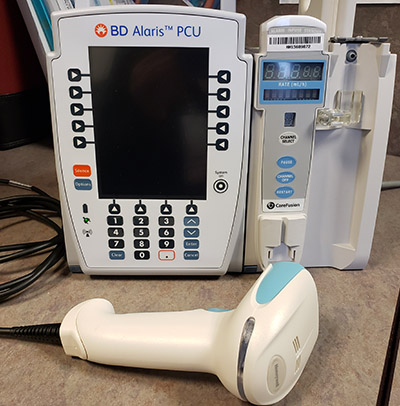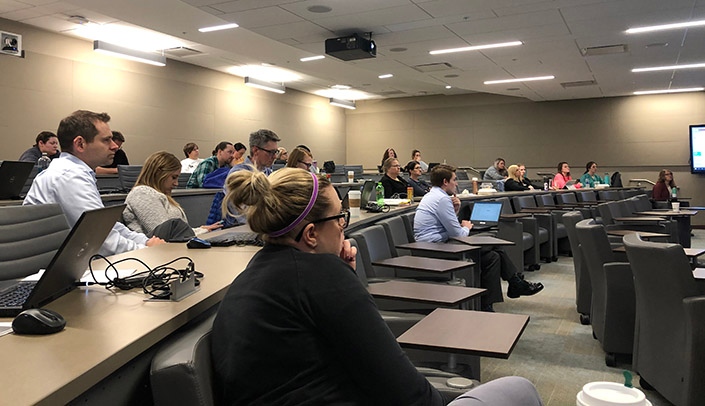A change is coming to the way intravenous (IV) medications are infused at Nebraska Medicine. It’s a change many would say is overdue and will dramatically reduce the risk for medication errors to patients.
 |
The new software inside this Alaris pump will receive the medication order directly from One Chart, no longer requiring a nurse to manually program the information. |
An Alaris infusion pump is used to administer IV medications to patients in inpatient rooms, infusion centers and procedural areas.
“Right now, the current process involves a nurse manually programming the information into the pump — the rate, dose, volume, patient weight, medical record number and drug name,” said Stacie Ethington, medication safety nurse specialist. “There is huge room for error.”
Thanks to a capital investment of $6.2 million, the Alaris pumps have been upgraded with software, referred to as interoperability, that makes it possible for electronic medical records to feed the medication order into the pump automatically.
“This technology allows the pump to talk to One Chart and for One Chart to talk to the pump,” said Lauren Hood, clinical informatics lead.
When all of the programming work is finished, which is expected to be sometime in March 2020, a nurse will simply scan a patient’s wristband, scan the medication, scan the pump and press “start.” At this time, front-line nurses who have volunteered to be subject matter experts on this workflow will test all medication records for accuracy before the project goes live.
“This software is going to greatly reduce the number of steps a nurse must take,” Ethington said. “Right now, we’re relying on a human to go through a complex workflow. We see programming errors every day in our SOS reporting. Anytime you can automate a workflow, it’s going to be safer for the patient.”
“This technology reduces the risk of human error,” Hood said. “The software automatically selects the medication in Alaris and sends over the details, such as dose, rate and volume to be infused.”
Another big piece of this work involves programming the medications’ safety settings into the software. To date, the pharmacy team has tested approximately 50 medications for interoperability. The group will continue to update and review hundreds of medication orders and entries in the Alaris pump library. This work will continue into next spring as preparations for full record testing and implementation continue.
“In addition to pharmacy representatives from the One Chart team and Medication Safety, the pharmacy team also includes a pharmacist representative from pediatrics, NICU, ICU, ED, oncology, and medical/surgical,” said Nick Crites, Pharm.D., medication safety pharmacist. “The project team is grateful for the time the front-line pharmacists will contribute to this project since validating and testing each of the hundreds of medications is crucial to patient safety and success of the project.”
The go-live date is set for June 16, 2020.
“If you ask me what keeps me up at night, I would say it’s the risk of pump programming errors,” Ethington said.
“This technology is a big win for patient safety and puts us in good company with other leading hospitals in the United States,” Hood said.
